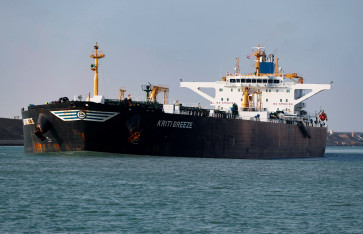BI: Risks remain amid offshore debt decline
Indonesia is not out of the woods yet and risks remain, even though its external debts have shown a downward trend in the third quarter this year, as shown by the latest statistics by Bank Indonesia (BI)
Change Size

Indonesia is not out of the woods yet and risks remain, even though its external debts have shown a downward trend in the third quarter this year, as shown by the latest statistics by Bank Indonesia (BI).
According to an external debt report published by BI on Wednesday, the total amount of offshore loans fell to US$302.41 billion by the end of September from the $304.51 billion posted at the end of June.
The decline was triggered by lower debts from both the public and private sector during the period.
The public sector ' consisting of the government and the central bank ' recorded $134.21 billion in combined debt; 0.3 percent lower than that in the second quarter.
Meanwhile, the private sector ' comprised of banks and non-banking firms ' saw its debts drop 1 percent quarter-to-quarter (qtq) to $168.21 billion. Almost all economic sectors reported declining debts by the end of the third quarter, with the exception of manufacturing, electricity, gas and water, trading and hotels, and services sectors.
Finance, which makes up for the largest component of the total figure, saw its offshore loans fall 1.1 percent on a quarterly basis, while agriculture and mining posted a monthly decline of 1.7 percent and 2.9 percent, respectively.
The report also revealed that the annualized tier-1 debt service ratio (DSR) ' which covers repayment of principal and interest on long-term external debt and payment of interest on short-term external debt ' shrank slightly to 19.4 percent in the third quarter from 19.5 percent in the previous quarter.
However, tier-2 DSR ' which covers total repayment of principal and interest on debt related to direct investment ' climbed to 57.5 percent from 53.4 percent during the same period.
A slight increase was recorded in the overall ratio of debt to gross domestic product (GDP), which climbed to 34.9 percent from 34.5 percent.
Maybank Indonesia economist Juniman attributed the third-quarter result to economic slowdown and weak commodity prices.
'This was largely reflected in the agriculture and mining sectors. Companies are now more selective in applying for new loans. They can't expand operations as aggressively as before because prices are down and the economy is not growing,' he said.
He added that the third quarter was normally a 'refinancing period', during which companies paid off their loans. 'But this time, they preferred not to extend or sign new loans for the aforementioned reason.'
Juniman also highlighted BI's regulation on offshore loans that he said had put a brake on the private sector's external debts.
The regulation, which was issued in October 2014, requires firms to hedge their loans to prevent them from spiking as a result of exchange rate volatility.
Meanwhile, Bank Central Asia (BCA) chief economist David Sumual noted that businesses had adopted a 'wait-and-see' approach in the third quarter that slowed down business expansion and eventually the pace of external debts.
'To them, business challenges were greater than the prospects,' he said.
Despite the lower external debts, both Juniman and David said that risks still loomed on the horizon that could affect the private sector's loan repayment ability.
The planned increase of the Fed's fund rate in the US and further economic slowdown in China are considered to be the two major risks to the debts as they may send shockwaves across financial markets again.
'We must pay close attention to short-term offshore loans because the figure has reached half of our foreign exchange reserves. These loans are vulnerable to shocks,' David said.
_____________________________________
To receive comprehensive and earlier access to The Jakarta Post print edition, please subscribe to our epaper through iOS' iTunes, Android's Google Play, Blackberry World or Microsoft's Windows Store. Subscription includes free daily editions of The Nation, The Star Malaysia, the Philippine Daily Inquirer and Asia News.
For print subscription, please contact our call center at (+6221) 5360014 or subscription@thejakartapost.com









